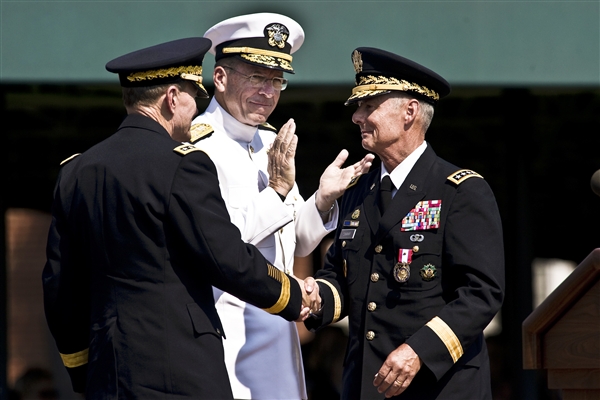WASHINGTON, Feb. 29, 2012 — Planned reductions to U.S. forces in Europe is an extension of the post-Cold War drawdown that is both manageable and appropriate in the new global context, the commander of U.S. European Command told Congress today.
Navy Adm. James G. Stavridis, who also serves as the NATO supreme allied commander for Europe, told the House Armed Services Committee that the planned 15 percent reduction of U.S. troops based in Europe would bring the current level of about 96,000 troops down to 68,000. The U.S. presence in Europe already is down about 75 percent from its high of about 400,000 troops in Europe at the height of the Cold War, he said.
The Defense Department’s fiscal 2013 budget request calls for two heavy brigade combat teams and two air squadrons to leave Europe next year and in fiscal 2014. The budget proposal was based on the new strategic military guidance developed over months of discussions among combatant commanders and other military leaders, Stavridis said.
“I support the strategy, and I support this reduction,” he said.
The admiral said there are many reasons for the military to maintain its European presence: Europe’s economic base, which amounts to about 25 percent of the world’s gross domestic product; its central location for getting U.S. forces to Africa, the Middle East and South and Central Asia; the NATO alliance; and the longstanding military-to-military relations and training opportunities.
“Europe is a very broad geo-strategic platform,” he said. “This is a part of the world that really shares our values. We stand with Europe in many, many ways philosophically. For all those reasons, Europe will continue to matter, and I hope we’ll approach [downsizing] in a balanced way.”
European Command worked hard in the past year on NATO campaigns in Libya, Afghanistan and the Balkans, Stavridis said. It works continuously to strengthen partnerships for training and operations, and focuses on areas such as missile defense and countering cyber threats and drug trafficking, he added.
To mitigate any gaps or risks associated with the drawdown, Stavridis told the panel, the military would have a dedicated brigade combat team in Germany on a rotational basis available to deploy to Eastern Europe, the Baltic states or wherever it is needed. While European Command will lose some aircraft, he said, it will gain V‑22 Ospreys and is adding several ships to manage the U.S. missile defense system in Europe.
Asked about asymmetric threats in Europe, Stavridis said there were some 300 kinetic terrorist incidents ranging from bombings to assassinations in Europe last year, including the shooting of two U.S. airmen at a Frankfurt, Germany, airport, and that rioting in northern Kosovo in recent months left several NATO troops shot and dozens hospitalized.
Eucom will continue to work on its military partnerships so other nations fight alongside U.S. forces, the admiral said. Such relationships also are important to missions such as counterdrugs, counterpiracy and cyber defense, he noted.
Asked about possible future NATO partners, Stavridis named India and Brazil as worthy partners. He noted that 22 nations included in the international coalition in Afghanistan are not NATO members, including New Zealand and Tonga. Important non-NATO partnerships exist in the Mediterranean Dialogue, which allowed discussions about Libya last year, and the Istanbul Initiative, which is a forum for Persian Gulf states to partner on anti-piracy efforts, he said.
Source:
U.S. Department of Defense
Office of the Assistant Secretary of Defense (Public Affairs)

 von
von 
